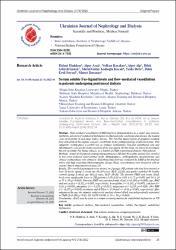Serum soluble Fas-ligand levels and flow-mediated vasodilation in patients undergoing peritoneal dialysis

Göster/
Tarih
2022Yazar
Huddam, BülentAzak, Alper
Karakus, Volkan
Alp, Alper
Gibyeli Genek, Dilek
Kocak, Meral Gülay Kadıoğlu
Dere, Yelda
Soysal, Dilek Ersil
Duranay, Murat
Üst veri
Tüm öğe kaydını gösterKünye
Huddam B, Azak A, Karakus V, Alp A, Genek DG, Kocak MGK, et al. Serum soluble Fas-ligand levels and flow-mediated vasodilation in patients undergoing peritoneal dialysis. Ukr J Nephr Dial. 2022;2(74): 25-32. doi: 10.31450/ukrjnd.2(74).2022.04.Özet
Flow-mediated vasodilation (FMD) has been demonstrated to be a useful, non-invasive tool for the detection ofendothelialdysfunction in atherosclerotic cardiovascular disease, the leading cause of mortality in end-stage kidney disease. The Fas/Fas ligand system of apoptosis resulting from activation of the caspase cascade- contributes to the pathophysiology of atherosclerosis. This ‘apoptotic’ system plays a central role in immune homeostasis. Vascular endothelial cells and inflammatory cells are the main resources of the Fas ligand. In this study, we aimed to investigate the role of soluble Fas ligand (sFasL) as a marker of FMD in peritoneal dialysis (PD) patients. Methods. A total of 43 patients undergoing maintenance PD and 40 healthy donors were enrolled in this cross-sectional observational study. Demographics, anthropometric measurements and clinical examinations were obtained. Endothelial function was evaluated by FMD of the brachial artery with high-resolution ultrasonography. Serum sFasL concentrations were measured with an enzyme-linked immunosorbent assay kit. Results. The enrolled partisipants were devited on 2 groups: PD patients who had been treated at least 12 weeks (group 1; mean age 41±14 years, M/F: 22/21) and gender matched 40 healthy controls (group 2; mean age 50±12 years, M/F: 19/20). The forearm FMD and serum sFasL levels were significantly lower in PD patients (3.95±2.01 vs 8.83 ± 6.17; p<0.001 and 54 ± 24 vs 73 ± 30; p=0.001). Forearm FMD was correlated with sFasL (r=0.289; p=0.008), age, BMI and uric acid (r= 0,32; p=0.003, respectively), hemoglobin (r= 0,293; p=0.007), calcium (r= 0,26; p=0.016), phosphate (r=- 0,250; p=0.023), magnesium (r= 0,255; p=0.020), 24 h SBP (r=- 0,257; p=0.019), creatinine and iPTH (r=- 0.50 and r=- 0,45; p<0.001, respectively). After adjustment for age, the stepwise multivariate analysis showed sFasL was independently associated to FMD (β: 0.180; p=0.03, CI: 0.078-0.314). vs 73 ± 30; p=0.001). Conclusions. sFasL may be used as a simple screening marker for endothelial dysfunction in PD patients.

















